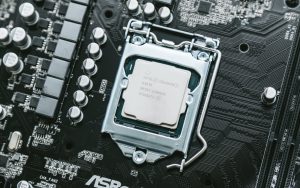Linux系でマザーボードやCPUの温度を取得する方法
Linuxでは標準で(マザーボードやCPUが対応していれば)温度センサーの値を取得できます。
検証したバージョン
- CentOS Linux 7.2.1511
- lm_sensors 3.4.0
マザーボードの温度を取得する
sysfs経由で温度を取得できます。
# cat /sys/class/thermal/thermal_zone0/temp
40000
40000は40.000℃です。
zone0となっている箇所はマザーボード上に複数温度センサーがある場合はzone1、zone2のようになるようです。
どの値がどの部分の温度かは、マザーボート等のマニュアルを参照しないと知ることができないです。
CPUの温度を取得する
CPUの温度はlabelが用意されているので、どのコアの温度がわかります。
# cd /sys/devices/platform/coretemp.0
# cat temp2_label
Core 0
# cat temp2_input
45000
# cat temp3_label
Core 1
# cat temp3_input
52000
Core0:45.000℃
Core1:52.000℃
上記のようになります。
lm_sensorsを使用する
lm_sensorsをインストールすればsensorsコマンドで確認することができます。
lm_sensorsインストール
# yum install lm_sensors
~
インストール:
lm_sensors.x86_64 0:3.4.0-8.20160601gitf9185e5.el7
依存性を更新しました:
lm_sensors-libs.x86_64 0:3.4.0-8.20160601gitf9185e5.el7
完了しました!
sensorsコマンド
lm_sensorsインストール後にsensorsコマンドで温度を見ることができます。
# sensors
acpitz-virtual-0
Adapter: Virtual device
temp1: +40.0°C (crit = +120.0°C)
coretemp-isa-0000
Adapter: ISA adapter
Core 0: +45.0°C (high = +86.0°C, crit = +100.0°C)
Core 1: +52.0°C (high = +86.0°C, crit = +100.0°C)
temp1がマザーボード、Core0とCore1がCPUですね。
先ほど直接確認した際の値を同じです。
他のセンサーの値を取得
sensors-detectで設定すればファンの回転数など温度以外のセンサーの値も取得できるようです。
私の使用しているサーバでは温度以外は取得できませんでした。
古い機種なのでセンサーがないのかな??
sensors-detectコマンドを実行すると、いろいろ質問されますが、
基本的には全てEnter(yes)でOKです。
[root@centos001 ~]# sensors-detect
# sensors-detect revision 3.4.0-8 (2016-06-01)
# System: Dell Inc. Vostro 200
# Board: Dell Inc. 0RK936
# Kernel: 3.10.0-327.36.1.el7.x86_64 x86_64
# Processor: Intel(R) Core(TM)2 Duo CPU E4600 @ 2.40GHz (6/15/13)
This program will help you determine which kernel modules you need
to load to use lm_sensors most effectively. It is generally safe
and recommended to accept the default answers to all questions,
unless you know what you're doing.
Some south bridges, CPUs or memory controllers contain embedded sensors.
Do you want to scan for them? This is totally safe. (YES/no):
Silicon Integrated Systems SIS5595... No
VIA VT82C686 Integrated Sensors... No
VIA VT8231 Integrated Sensors... No
AMD K8 thermal sensors... No
AMD Family 10h thermal sensors... No
AMD Family 11h thermal sensors... No
AMD Family 12h and 14h thermal sensors... No
AMD Family 15h thermal sensors... No
AMD Family 16h thermal sensors... No
AMD Family 17h thermal sensors... No
AMD Family 15h power sensors... No
AMD Family 16h power sensors... No
Intel digital thermal sensor... Success!
(driver `coretemp')
Intel AMB FB-DIMM thermal sensor... No
Intel 5500/5520/X58 thermal sensor... No
VIA C7 thermal sensor... No
VIA Nano thermal sensor... No
Some Super I/O chips contain embedded sensors. We have to write to
standard I/O ports to probe them. This is usually safe.
Do you want to scan for Super I/O sensors? (YES/no):
Probing for Super-I/O at 0x2e/0x2f
Trying family `National Semiconductor/ITE'... No
Trying family `SMSC'... No
Trying family `VIA/Winbond/Nuvoton/Fintek'... No
Trying family `ITE'... Yes
Found `ITE IT8718F Super IO Sensors' Success!
(address 0x290, driver `it87')
Probing for Super-I/O at 0x4e/0x4f
Trying family `National Semiconductor/ITE'... No
Trying family `SMSC'... No
Trying family `VIA/Winbond/Nuvoton/Fintek'... No
Trying family `ITE'... No
Some systems (mainly servers) implement IPMI, a set of common interfaces
through which system health data may be retrieved, amongst other things.
We first try to get the information from SMBIOS. If we don't find it
there, we have to read from arbitrary I/O ports to probe for such
interfaces. This is normally safe. Do you want to scan for IPMI
interfaces? (YES/no):
# DMI data unavailable, please consider installing dmidecode 2.7
# or later for better results.
Probing for `IPMI BMC KCS' at 0xca0... No
Probing for `IPMI BMC SMIC' at 0xca8... No
Some hardware monitoring chips are accessible through the ISA I/O ports.
We have to write to arbitrary I/O ports to probe them. This is usually
safe though. Yes, you do have ISA I/O ports even if you do not have any
ISA slots! Do you want to scan the ISA I/O ports? (yes/NO):
Lastly, we can probe the I2C/SMBus adapters for connected hardware
monitoring devices. This is the most risky part, and while it works
reasonably well on most systems, it has been reported to cause trouble
on some systems.
Do you want to probe the I2C/SMBus adapters now? (YES/no):
Using driver `i2c-i801' for device 0000:00:1f.3: Intel ICH9
Module i2c-dev loaded successfully.
Next adapter: i915 gmbus ssc (i2c-0)
Do you want to scan it? (yes/NO/selectively):
Next adapter: i915 gmbus vga (i2c-1)
Do you want to scan it? (yes/NO/selectively):
Next adapter: i915 gmbus panel (i2c-2)
Do you want to scan it? (yes/NO/selectively):
Next adapter: i915 gmbus dpc (i2c-3)
Do you want to scan it? (yes/NO/selectively):
Next adapter: i915 gmbus dpb (i2c-4)
Do you want to scan it? (yes/NO/selectively):
Next adapter: i915 gmbus dpd (i2c-5)
Do you want to scan it? (yes/NO/selectively):
Next adapter: SMBus I801 adapter at 0500 (i2c-6)
Do you want to scan it? (yes/NO/selectively):
Now follows a summary of the probes I have just done.
Just press ENTER to continue:
Driver `it87':
* ISA bus, address 0x290
Chip `ITE
Driver `coretemp':
* Chip `Intel digital thermal sensor' (confidence: 9)
Do you want to overwrite /etc/sysconfig/lm_sensors? (YES/no):
Unloading i2c-dev... OK
まとめ
マザーボードやCPUの温度を取得する方法でした。
実際何に使うのか悩ましいですが、定期的に温度を取得して一定の温度に達したらアラート飛ばすとか。
ファンや冷却部分に異常がないか確認するとかですかね。
SSDの適正温度は0~60度のようなので、70度超えると安全装置が働き、パフォーマンスが下がるらしいです。
SSDの温度も取得できるのだろうか、使用したサーバはHDDなので確認できませんでした。



